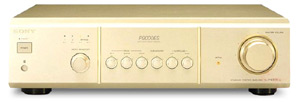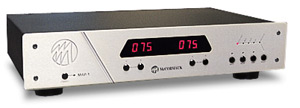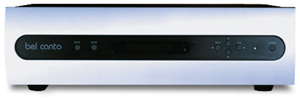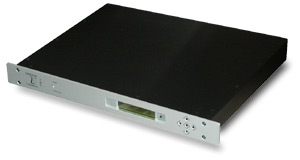![[SoundStage!]](../sslogo3.gif) Surrounded! Surrounded!Back Issue Article |
September 2002 Multichannel Music's Swiss Army Knife: The Multichannel Preamp In June’s "Surrounded!" column we looked at a multichannel music system that was easy to set up and use. The system I discussed was actually a hybrid configuration in that it was optimized for multichannel music, but was more than adequate for home-theater duty as well. Implementing either of the new high-resolution music formats -- DVD-Audio or SACD -- requires the listener to make some choices about the components that will be used in the system. Perhaps the biggest drawback to audiophiles wanting multichannel capability without all of the complexity and compromise of a home-theater processor is what to route the source-player’s six-channel outputs into. How do you control volume, source selection, and balance the listening level for six channels? I’ve actually heard of a few extreme examples; one instance was of a listener who adopted the use of three stereo preamps in the same system! In today’s market, that’s unnecessary. This is where the multichannel preamp comes in. I like to call it the Swiss Army knife of multichannel audio; it is the right tool at the right time, and it seems to do exactly what we need. Putting processing where it belongs I’m glad to see so many manufacturers putting that pesky disc processing where it belongs, which is in the source player! If I’ve said it once, I’ve said it a hundred times: "If we’re being forced to use the analog outputs of the DVD-A or SACD player anyway, why not use them exclusively for all of our playback material?" We have a plethora of high-resolution source players with DTS and Dolby Digital built in, obviating the need for external home-theater processors -- at least for most of us. There are those who like the extra flexibility offered by a first-rate A/V processor. Most audiophiles, though, find the basic processing in many of the current players quite adequate, if they need it at all. What is really exciting is the new world of high-quality multichannel preamps. They are getting really good, and they are available at almost any price point. Comfort level If you’re accustomed to using a simple two-channel preamp and you try to program and use an A/V processor, it’s quite likely that you’ll commit hara-kiri. The complexity can be maddening. And the array of features can be a waste of money for a music-only system. The multichannel preamp is different. Most audiophiles I’ve introduced it to settle right into the use of this new star on the audio-gear horizon. It’s intuitive for most of us, because it operates just like a two-channel preamp in most respects -- just times three. (Let’s see -- two channels goes into six…. Yep, that’s right.) The differences between the stereo preamp and the multichannel preamp are usually minimal, but there is one worth noting. With a typical two-channel system, you have your left and right speakers equal distance from the listening position, and you’re driving them with a single stereo amplifier. These facts minimize the need for the left-to-right balance control, at least in most instances. In a multichannel system, however, you will most likely need to balance the levels of the five or six speakers. Why? It’s far more likely that your surrounds will be closer to your ears than your mains, and maybe your center-channel two. It’s just a function of the way most rooms are laid out (most people sit closer to the rear of the room than the front). And the subwoofer will definitely be out of whack -- it will sound either too loud or too soft in relation to the other speakers. These are the rules rather than the exceptions, and we need to have functionality to compensate for it. There are other considerations too. The various speakers in your system may be different models from the same maker or an altogether different manufacturer. They’ll have different efficiencies and driver complements. And you just may be using a different amplifier for your center-channel and/or surrounds (you will, unless you have a five-channel amp). So given the same volume setting, even if the speakers are set up optimally, you’ll still need to balance the levels. What all this means is that it is highly unlikely that you’ll have a perfectly balanced system all around without channel-balancing the speakers. Essentially, when you have the same signal playing in all speakers, the volume level for each individual speaker should be the same at the listening position. This is accomplished through the functionality built into the multichannel preamp. Each one is different, but the user’s manuals -- at least all the ones I’ve examined -- give explicit instructions on this most basic adjustment. Once all your interconnect cables -- all six of them -- are connected and the levels are balanced, you’ll be operating just like a conventional stereo system. You’ll have source selection and a volume control just like you’re used to. Now there may be the odd feature here and there, depending on the specific multichannel preamp, but you essentially will be using the multichannel preamp just like that old stereo preamp. Four beauties at four price points It’s exciting when good manufacturers sense the need of the consumer. And that’s what we have in this case. The below four multichannel preamps are some of the first to market, and one of them just might be exactly what you need to get into a killer multichannel music system. And even better, there’s choices available at many different price points.
It didn’t take folks long to figure out that
the TA-P9000ES was an excellent standalone unit. There’s a lot of hardware and value
packed into this baby, and it sounds and operates like a $2000-plus component. It has
old-fashioned knobs to twist for each channel’s balance, and then a large motorized,
master volume control that you can find in the dark. The remote control is a boon and
allows you to choose from two sets of six-channel inputs as well as a stereo input and a
bypass. McCormack MAP-1 ($2395): McCormack Audio, now manufactured by Conrad-Johnson in Fairfax Virginia, has long been known for high-value components. Even still, I was taken aback when I first saw detailed pictures of the MAP-1. How in the world were they able to put RCA jacks like those on a six-channel preamp? From the looks of the MAP-1, it appears to be a stunning bargain. Although I have yet to hear one, our very own
John Potis has been using one for some time now and there is a full review of it at Home Theater &
Sound. This unit is one to see, and you’ll like seeing the digital
volume readout etched into the attractive brushed-aluminum faceplate. Bel Canto Design PRe6 (Est. $3000-$3500): This long-anticipated multichannel preamp is one to watch. While I won’t go into all the pre-production propaganda about how good the PRe6 supposedly is, suffice it to say that Bel Canto Design is mighty proud of the PRe6 already. The PRe6 sports some features that set it apart
from the crowd (well there isn’t quite a crowd yet) like balanced
outputs on all channels (to use with Bel Canto Design’s own eVo-series amplifiers,
among others),and a digitally controlled analog volume control. Orpheus Laboratories Two ($6270): Talking to the guys at Orpheus Laboratories during our trip to High End 2002 in Frankfurt Germany was a treat. When I heard this Swiss company was producing a multichannel preamp, my eyes lit up. I’m not going to break all the news about this exciting unit right now; we’ll be taking a very close look at it in the coming months. But I’m listening to it as I write this, and I can tell you it is among the finest preamps, stereo included, that I’ve heard at any price. If that’s not enough to keep you coming back, I guess I’ll have to resort to giving away free audio equipment! See ya next month. ...Jeff Fritz
|
|
![[SoundStage!]](../sslogo3.gif) All Contents All ContentsCopyright © 2002 SoundStage! All Rights Reserved |
 Sony TA-P9000ES ($750 USD): The
Sony TA-P9000ES was one of the first multichannel preamps out of the gates. It was
originally designed as an add-on to the Sony TA-E9000ES preamp/processor. That unit,
designed for home theater, lacked the ability to handle Sony’s own SACD format. Sony
needed a patch, and the TA-P9000ES was it.
Sony TA-P9000ES ($750 USD): The
Sony TA-P9000ES was one of the first multichannel preamps out of the gates. It was
originally designed as an add-on to the Sony TA-E9000ES preamp/processor. That unit,
designed for home theater, lacked the ability to handle Sony’s own SACD format. Sony
needed a patch, and the TA-P9000ES was it.  Although I recently
retired this unit from my system, as there’s now alternative competition for the Sony
that I’m listening to, it’s still a pack leader in the price/performance
category.
Although I recently
retired this unit from my system, as there’s now alternative competition for the Sony
that I’m listening to, it’s still a pack leader in the price/performance
category. It also has a proprietary
ambience-retrieval mode for use with two-channel recordings. The MAP-1 has two sets of
six-channel inputs and facilities for three stereo sources.
It also has a proprietary
ambience-retrieval mode for use with two-channel recordings. The MAP-1 has two sets of
six-channel inputs and facilities for three stereo sources.  There are two sets of six-channel
inputs, five (!) stereo inputs, and an RS-232 serial port. We hope to have one to evaluate
very soon.
There are two sets of six-channel
inputs, five (!) stereo inputs, and an RS-232 serial port. We hope to have one to evaluate
very soon.